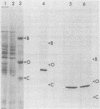Abstract
We describe the isolation and characterization of a series of 5-fluorodeoxyuridine (FdUrd)-resistant mouse 3T6 cell lines that overproduce thymidylate synthetase (TS) by up to 50-fold compared with the parental cells. The resistant cells were selected by growing 3T6 cells or a methotrexate-resistant 3T6 cell line (M50L3, isolated previously in our laboratory) in gradually increasing concentrations of FdUrd. Uridine and cytidine were included in the culture medium to reduce toxicity from metabolic products of FdUrd. Cells that were resistant to the drug by virtue of loss of thymidine kinase activity were eliminated by selection in medium containing hypoxanthine, methotrexate, and thymidine. M50L3 cells were found to adapt to FdUrd more readily than 3T6 cells. A number of clones were isolated that were able to grow in the presence of 3 microM (M50L3 derived) or 0.3 microM (3T6 derived) FdUrd. Several were found to overproduce TS by 10 to 50-fold compared with normal 3T6 cells. All were found to have thymidine kinase activity, although the enzyme level was significantly reduced in some clones. The overproduced TS was inactivated by 5-fluorodeoxyuridylic acid at the same concentration as the enzyme from 3T6 cells. TS was purified from the LU3-7 clone (50-fold overproducer) by affinity chromatography on methotrexate-polyacrylamide. The monomer molecular weight was about 38,000, which was the same as the molecular weight of the monomer in 3T6 cells. The overproduction trait was gradually lost (half-life, 3 weeks) when LU3-7 cells were grown in the absence of FdUrd. The overproducing cells will provide an abundant supply of TS and (very likely) its mRNA and may serve as a convenient model system for detailed studies of the regulation of TS gene expression during the cell cycle.
Full text
PDF

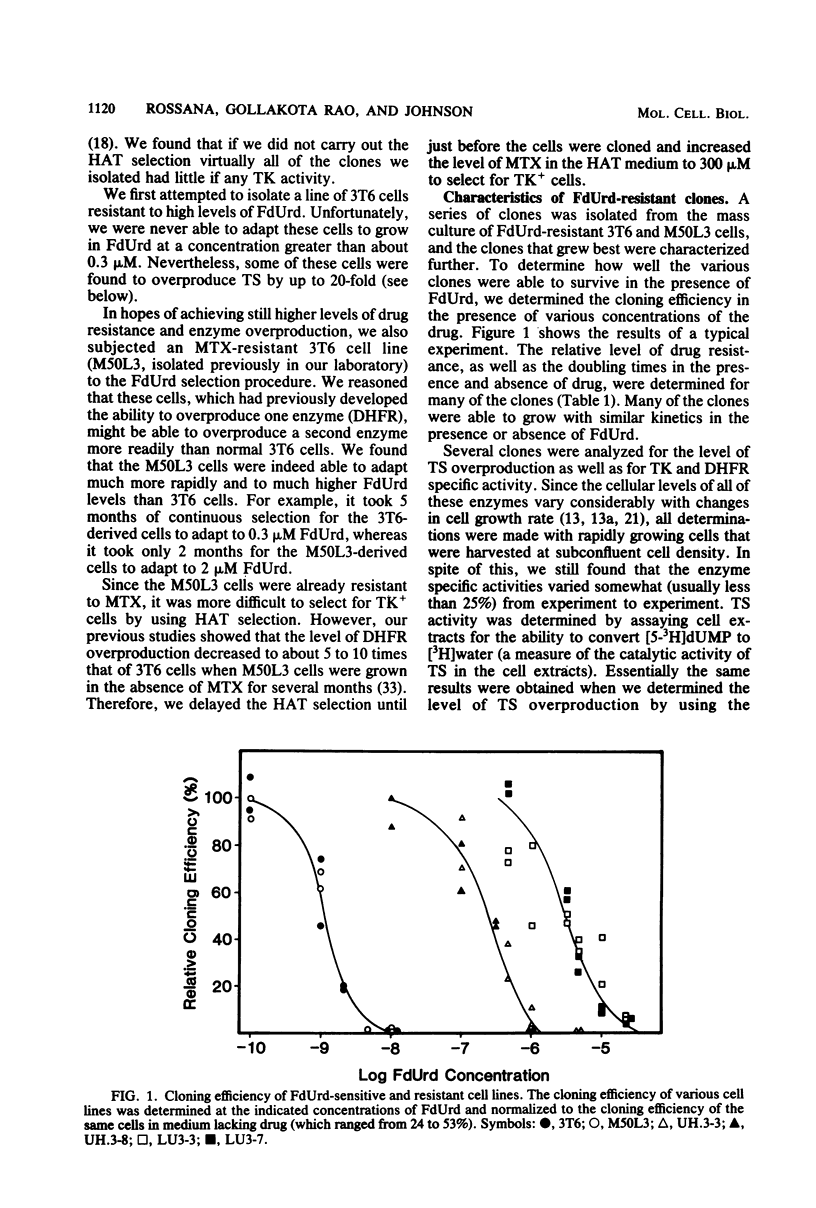
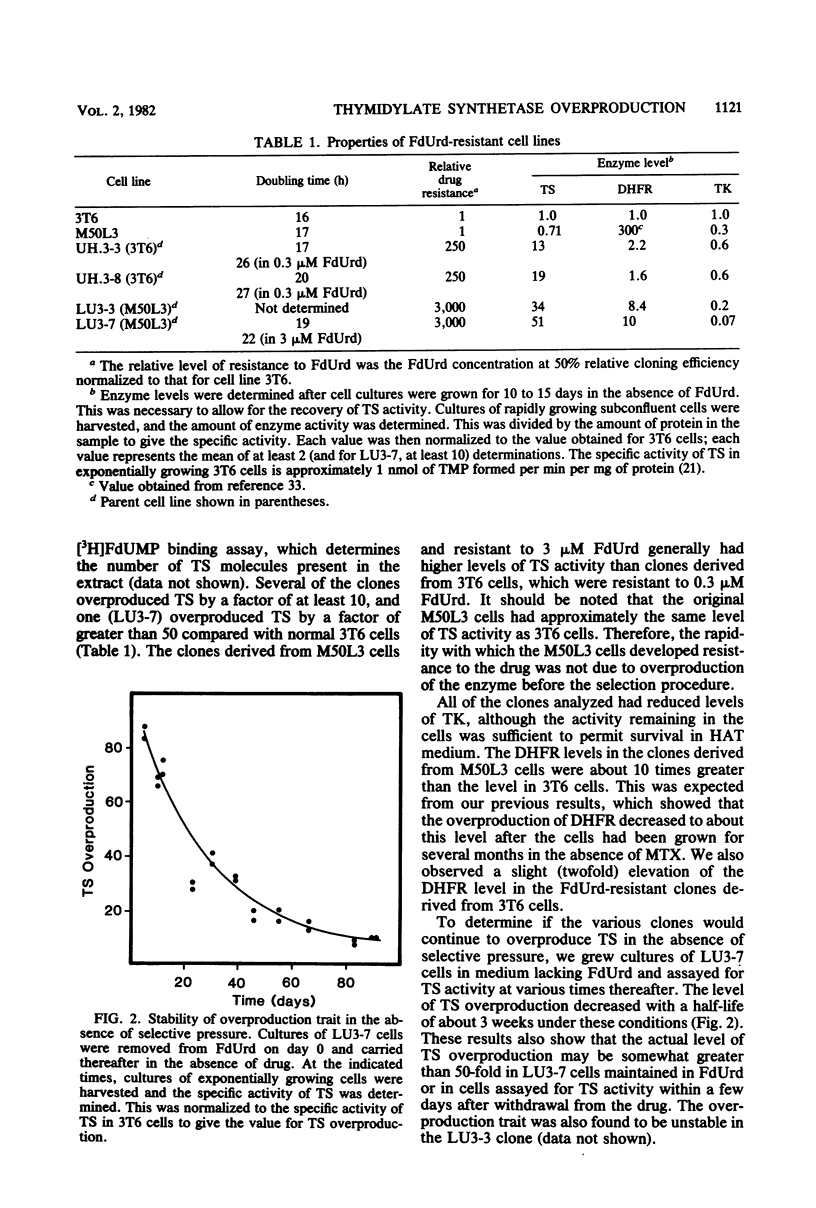
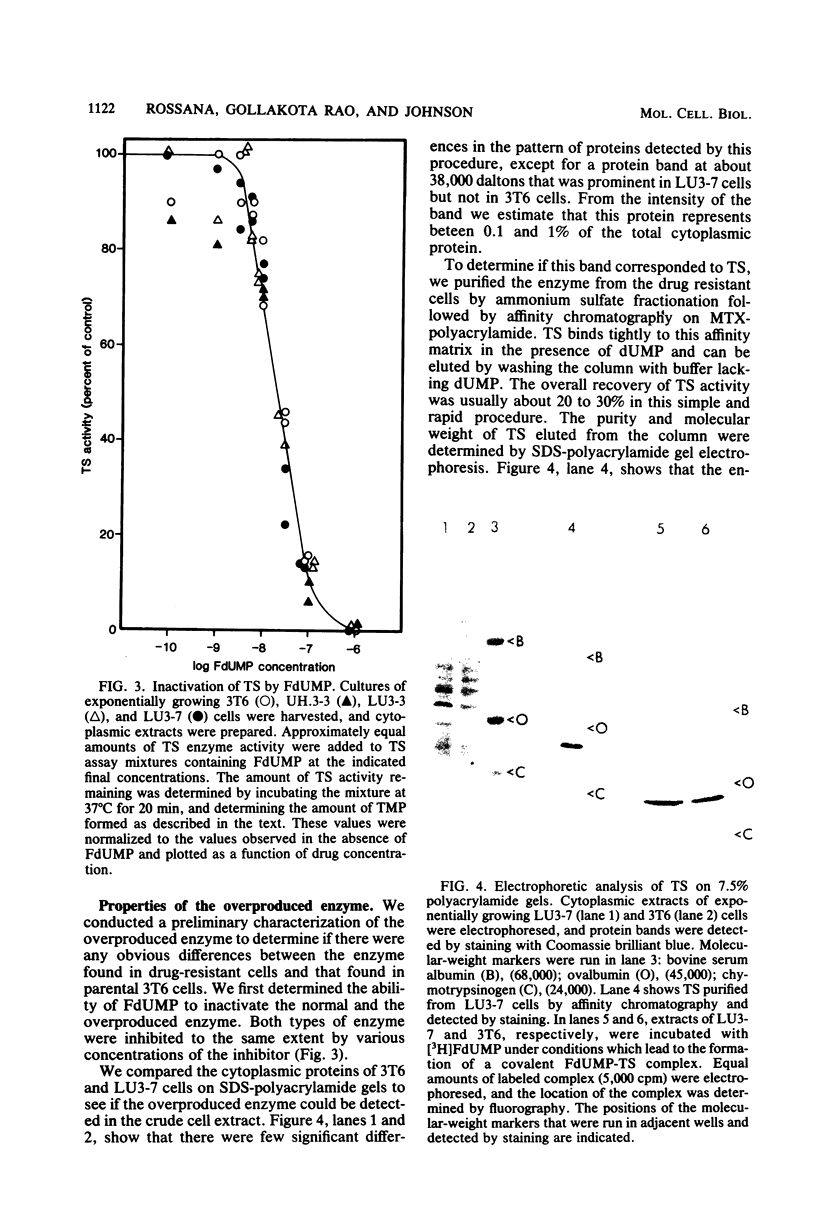
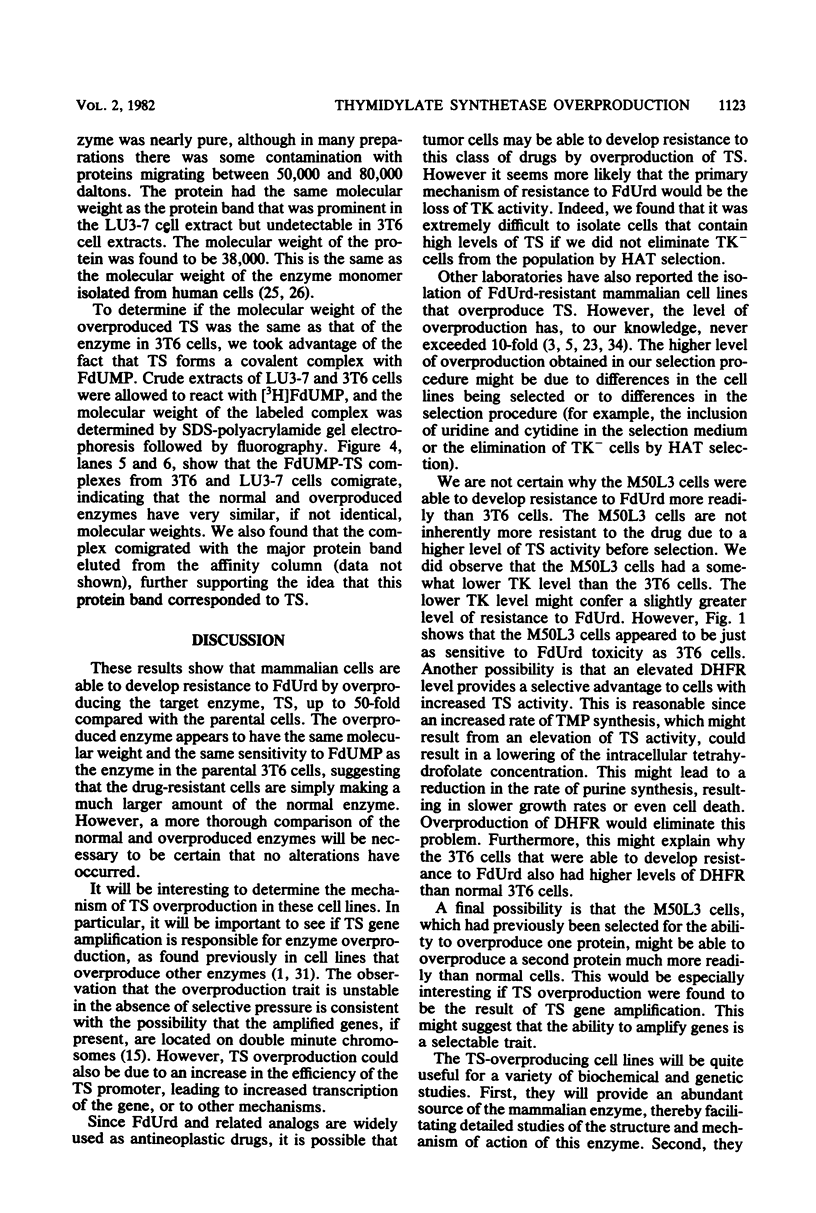

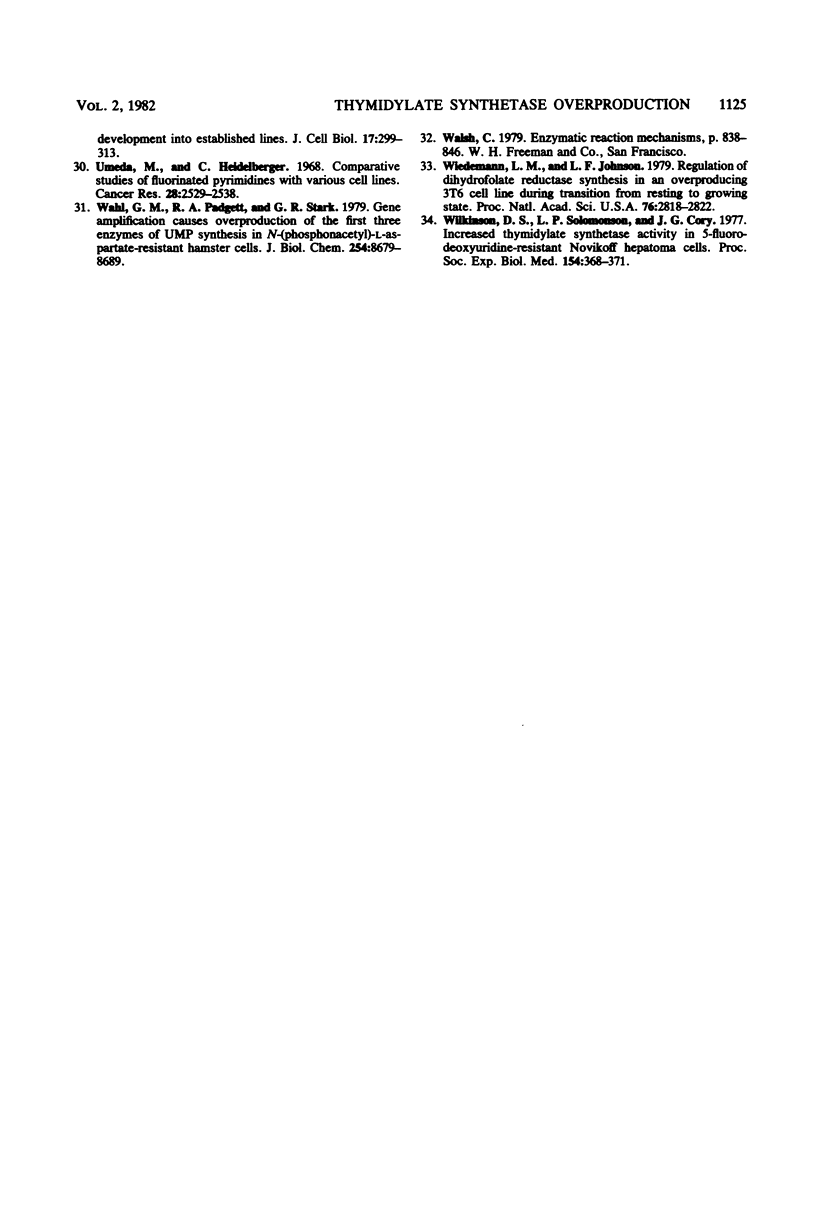
Images in this article
Selected References
These references are in PubMed. This may not be the complete list of references from this article.
- Alt F. W., Kellems R. E., Bertino J. R., Schimke R. T. Selective multiplication of dihydrofolate reductase genes in methotrexate-resistant variants of cultured murine cells. J Biol Chem. 1978 Mar 10;253(5):1357–1370. [PubMed] [Google Scholar]
- Alt F. W., Kellems R. E., Schimke R. T. Synthesis and degradation of folate reductase in sensitive and methotrexate-resistant lines of S-180 cells. J Biol Chem. 1976 May 25;251(10):3063–3074. [PubMed] [Google Scholar]
- Baskin F., Carlin S. C., Kraus P., Friedkin M., Rosenberg R. N. Experimental chemotherapy of neuroblastoma. II. Increased thymidylate synthetase activity in a 5-fluorodeoxyuridine-resistant variant of mouse neuroblastoma. Mol Pharmacol. 1975 Jan;11(1):105–117. [PubMed] [Google Scholar]
- Baskin F., Davis R., Rosenberg R. N. Altered thymidine kinase or thymidylate synthetase activities in 5-fluoro deoxyuridine resistant variants of mouse neuroblastoma. J Neurochem. 1977 Dec;29(6):1031–1037. doi: 10.1111/j.1471-4159.1977.tb06506.x. [DOI] [PubMed] [Google Scholar]
- Baskin F., Rosenberg R. N. A comparison of thymidylate synthetase activities from 5-fluorodeoxyuridine sensitive and resistant variants of mouse neuroblastoma. J Neurochem. 1975 Sep;25(3):233–238. doi: 10.1111/j.1471-4159.1975.tb06958.x. [DOI] [PubMed] [Google Scholar]
- Brdar B., Rifkin D. B., Reich E. Studies of Rous sarcoma virus. Effects of nucleoside analogues on virus synthesis. J Biol Chem. 1973 Apr 10;248(7):2397–2408. [PubMed] [Google Scholar]
- Danenberg P. V. Thymidylate synthetase - a target enzyme in cancer chemotherapy. Biochim Biophys Acta. 1977 Dec 23;473(2):73–92. doi: 10.1016/0304-419x(77)90001-4. [DOI] [PubMed] [Google Scholar]
- Dolnick B. J., Cheng Y. c. Human thymidylate synthetase derived from blast cells of patients with acture myelocytic leukemia. Purification and chracterization. J Biol Chem. 1977 Nov 10;252(21):7697–7703. [PubMed] [Google Scholar]
- HAKALA M. T., ZAKRZEWSKI S. F., NICHOL C. A. Relation of folic acid reductase to amethopterin resistance in cultured mammalian cells. J Biol Chem. 1961 Mar;236:952–958. [PubMed] [Google Scholar]
- Heidelberger C. Fluorinated pyrimidines. Prog Nucleic Acid Res Mol Biol. 1965;4:1–50. doi: 10.1016/s0079-6603(08)60783-7. [DOI] [PubMed] [Google Scholar]
- Ives D. H., Durham J. P., Tucker V. S. Rapid determination of nucleoside kinase and nucleotidase activities with tritium-labeled substrates. Anal Biochem. 1969 Apr 4;28(1):192–205. doi: 10.1016/0003-2697(69)90170-5. [DOI] [PubMed] [Google Scholar]
- Johnson L. F., Fuhrman C. L., Wiedemann L. M. Regulation of dihydrofolate reductase gene expression in mouse fibroblasts during the transition from the resting to growing state. J Cell Physiol. 1978 Dec;97(3 Pt 2 Suppl 1):397–306. doi: 10.1002/jcp.1040970314. [DOI] [PubMed] [Google Scholar]
- Johnson L. F., Rao L. G., Muench A. J. Regulation of thymidine kinase enzyme level in serum-stimulated mouse 3T6 fibroblasts. Exp Cell Res. 1982 Mar;138(1):79–85. doi: 10.1016/0014-4827(82)90093-3. [DOI] [PubMed] [Google Scholar]
- Kamen B. A., Takach P. L., Vatev R., Caston J. D. A rapid, radiochemical-ligand binding assay for methotrexate. Anal Biochem. 1976 Jan;70(1):54–63. doi: 10.1016/s0003-2697(76)80047-4. [DOI] [PubMed] [Google Scholar]
- Kaufman R. J., Brown P. C., Schimke R. T. Amplified dihydrofolate reductase genes in unstably methotrexate-resistant cells are associated with double minute chromosomes. Proc Natl Acad Sci U S A. 1979 Nov;76(11):5669–5673. doi: 10.1073/pnas.76.11.5669. [DOI] [PMC free article] [PubMed] [Google Scholar]
- Kempe T. D., Swyryd E. A., Bruist M., Stark G. R. Stable mutants of mammalian cells that overproduce the first three enzymes of pyrimidine nucleotide biosynthesis. Cell. 1976 Dec;9(4 Pt 1):541–550. doi: 10.1016/0092-8674(76)90036-2. [DOI] [PubMed] [Google Scholar]
- LITTLEFIELD J. W. SELECTION OF HYBRIDS FROM MATINGS OF FIBROBLASTS IN VITRO AND THEIR PRESUMED RECOMBINANTS. Science. 1964 Aug 14;145(3633):709–710. doi: 10.1126/science.145.3633.709. [DOI] [PubMed] [Google Scholar]
- LOWRY O. H., ROSEBROUGH N. J., FARR A. L., RANDALL R. J. Protein measurement with the Folin phenol reagent. J Biol Chem. 1951 Nov;193(1):265–275. [PubMed] [Google Scholar]
- Laemmli U. K. Cleavage of structural proteins during the assembly of the head of bacteriophage T4. Nature. 1970 Aug 15;227(5259):680–685. doi: 10.1038/227680a0. [DOI] [PubMed] [Google Scholar]
- Lockshin A., Moran R. G., Danenberg P. V. Thymidylate synthetase purified to homogeneity from human leukemic cells. Proc Natl Acad Sci U S A. 1979 Feb;76(2):750–754. doi: 10.1073/pnas.76.2.750. [DOI] [PMC free article] [PubMed] [Google Scholar]
- Navalgund L. G., Rossana C., Muench A. J., Johnson L. F. Cell cycle regulation of thymidylate synthetase gene expression in cultured mouse fibroblasts. J Biol Chem. 1980 Aug 10;255(15):7386–7390. [PubMed] [Google Scholar]
- Newbold P. C., Harding N. G. Affinity chromatography of dihydrofolate reductase. Biochem J. 1971 Aug;124(1):1–12. doi: 10.1042/bj1240001. [DOI] [PMC free article] [PubMed] [Google Scholar]
- Priest D. G., Ledford B. E., Doig M. T. Increased thymidylate synthetase in 5-fluorodeoxyuridine resistant cultured hepatoma cells. Biochem Pharmacol. 1980 Jun 1;29(11):1549–1553. doi: 10.1016/0006-2952(80)90607-3. [DOI] [PubMed] [Google Scholar]
- Roberts D. An isotopic assay for thymidylate synthetase. Biochemistry. 1966 Nov;5(11):3546–3548. doi: 10.1021/bi00875a022. [DOI] [PubMed] [Google Scholar]
- Rode W., Scanlon K. J., Hynes J., Bertino J. R. Purification of mammalian tumor (L1210) thymidylate synthetase by affinity chromatography on stable biospecific adsorbent. Stabilization of the enzyme with neutral detergents. J Biol Chem. 1979 Nov 25;254(22):11538–11543. [PubMed] [Google Scholar]
- Santi D. V., McHenry C. S., Sommer H. Mechanism of interaction of thymidylate synthetase with 5-fluorodeoxyuridylate. Biochemistry. 1974 Jan 29;13(3):471–481. doi: 10.1021/bi00700a012. [DOI] [PubMed] [Google Scholar]
- Schimke R. T., Kaufman R. J., Alt F. W., Kellems R. F. Gene amplification and drug resistance in cultured murine cells. Science. 1978 Dec 8;202(4372):1051–1055. doi: 10.1126/science.715457. [DOI] [PubMed] [Google Scholar]
- TODARO G. J., GREEN H. Quantitative studies of the growth of mouse embryo cells in culture and their development into established lines. J Cell Biol. 1963 May;17:299–313. doi: 10.1083/jcb.17.2.299. [DOI] [PMC free article] [PubMed] [Google Scholar]
- Umeda M., Heidelberger C. Comparative studies of fluorinated pyrimidines with various cell lines. Cancer Res. 1968 Dec;28(12):2529–2538. [PubMed] [Google Scholar]
- Wahl G. M., Padgett R. A., Stark G. R. Gene amplification causes overproduction of the first three enzymes of UMP synthesis in N-(phosphonacetyl)-L-aspartate-resistant hamster cells. J Biol Chem. 1979 Sep 10;254(17):8679–8689. [PubMed] [Google Scholar]
- Wilkinson D. S., Solomonson L. P., Cory J. G. Increased thymidylate synthetase activity in 5-fluorodeoxyuridine-resistant Novikoff hepatoma cells. Proc Soc Exp Biol Med. 1977 Mar;154(3):368–371. doi: 10.3181/00379727-154-39673. [DOI] [PubMed] [Google Scholar]



